
1883 Mayhem Heritage Begins
Our Heritage: A Legacy of Courage and Commitment






We appreciate our families legacy. It is why we are where we are today!




Our story begins with my great-great-grandfather, Reverend A.E. Main, who made a life-changing decision in 1883. Leaving behind a comfortable life in Alfred, NY, he moved his family to Pomona Park, Florida, seeking relief for his newborn daughter’s breathing issues. Doctors recommended a warmer and more humid climate, and it was on this decision that he purchased the farm we cherish and proudly toil today.
The Great Labor Day Hurricane (1935)
In 1934, financial strain forced Dr. Main to close his practice. He re-enlisted in the Army, serving as a doctor for the WWI Veterans’ Work Camp in the Florida Keys. Tragically, on September 2, 1935, the Great Labor Day Hurricane struck, claiming the lives of 257 veterans and Dr. Main himself. Despite evacuation efforts by a family friend, he refused to leave until every other veteran had been safely evacuated.


A "Main " Family of Service and Resilience




The Spanish-American War (1898)
At just 22 years old, D.C. Main, A.E. Main’s son, answered the call to serve. Volunteering as a medic during the Spanish-American War, he may have stood alongside Teddy Roosevelt and the legendary Rough Riders.
The Rugged Ocklawaha River Expedition (1915)
At 39, Dr. D.C. Main undertook an extraordinary feat: mapping the first 12 miles of the rugged Ocklawaha River using only rudimentary tools. His hand-drawn map, now preserved in the U.S. National Archives, stands as a testament to his pioneering spirit.
The Great Depression (1920s-1930s)
After retiring from the Army in 1919, Dr. Main returned to Pomona Park to open a medical practice. When the Great Depression devastated the economy, his dedication to Putnam County residents never wavered. Even as payments dried up, he accepted whatever patients could offer—pies, bread, eggs, livestock, or even help on the farm.


Mayhem Minorcan Heritage
The Minorcan Voyage to Florida (1768)
The Minorcans’ journey to Florida is a story of resilience, determination, and a deep-rooted connection to the land. In 1768, over 1,400 Minorcans, along with Greeks and Italians, were brought to Florida by Andrew Turnbull to work as indentured laborers on his plantation in New Smyrna. The conditions were harsh, and many perished under the grueling demands of plantation life. After nine years of hardship, the survivors, led by Father Pedro Camps, walked north to St. Augustine, where they found refuge and established a lasting presence. The Minorcan community became an integral part of Florida’s cultural fabric, contributing their unique traditions, cuisine, and labor to the growth of the region.
Captain William A. Mickler (1860's) Fast forward to the post-Civil War era, and the narrative of resilience continues with Capt. William H. Mickler, Scott’s great-great-grandfather, whose life exemplifies leadership and service. Born in Beaufort, South Carolina, Capt. Mickler enlisted in the Confederate Army during the Civil War, serving under the renowned General Wade Hampton. His service to the South during a tumultuous period marked him as a man of dedication and discipline.


"Big Mema" Schill (1890's) Capt. Mickler moved to St. Johns County, Florida, a region rich in Minorcan heritage. In 1885, he married Josephine Reyes, a union that would result in a family legacy of 10 children, including Scott’s great-grandmother, Emma “Big Mema” Schill. Emma’s enduring influence on the family earned her a place of honor in their collective memory.
St John's County Commissioner (1903) Capt. Mickler’s contributions to his community extended beyond his family. He became a county commissioner, where his leadership helped shape the future of St. Johns County. In 1903, he was appointed Sergeant at Arms of the Florida Senate. Known for his "soldierly bearing," Capt. Mickler carried out his duties with the same discipline and dedication he had shown in military service, earning the respect of his peers.
Today, the legacy of the Minorcans and the Mickler family’s contributions to Florida’s history are celebrated and remembered. From the endurance of the Minorcan settlers to the leadership of figures like Capt. Mickler, their stories intertwine to form a rich tapestry that speaks to the strength and spirit of those who helped shape the Sunshine State.



